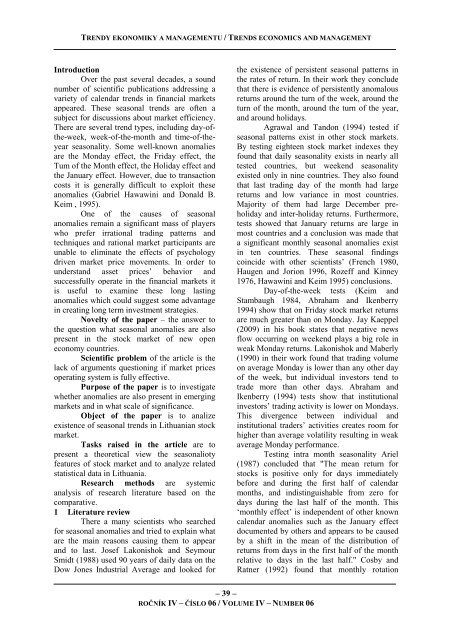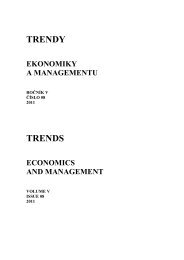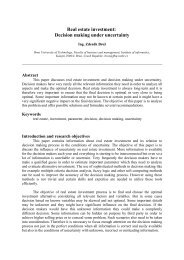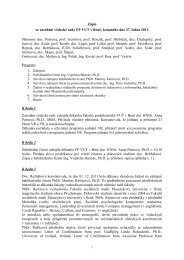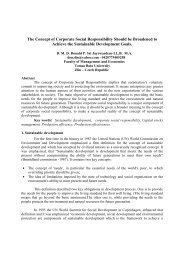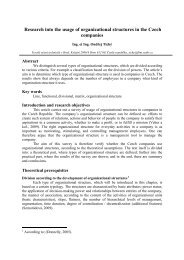Stáhnout toto číslo ve formátu PDF - Fakulta podnikatelská - Vysoké ...
Stáhnout toto číslo ve formátu PDF - Fakulta podnikatelská - Vysoké ...
Stáhnout toto číslo ve formátu PDF - Fakulta podnikatelská - Vysoké ...
Create successful ePaper yourself
Turn your PDF publications into a flip-book with our unique Google optimized e-Paper software.
TRENDY EKONOMIKY A MANAGEMENTU / TRENDS ECONOMICS AND MANAGEMENT<br />
Introduction<br />
O<strong>ve</strong>r the past se<strong>ve</strong>ral decades, a sound<br />
number of scientific publications addressing a<br />
variety of calendar trends in financial markets<br />
appeared. These seasonal trends are often a<br />
subject for discussions about market efficiency.<br />
There are se<strong>ve</strong>ral trend types, including day-ofthe-week,<br />
week-of-the-month and time-of-theyear<br />
seasonality. Some well-known anomalies<br />
are the Monday effect, the Friday effect, the<br />
Tum of the Month effect, the Holiday effect and<br />
the January effect. Howe<strong>ve</strong>r, due to transaction<br />
costs it is generally difficult to exploit these<br />
anomalies (Gabriel Hawawini and Donald B.<br />
Keim , 1995).<br />
One of the causes of seasonal<br />
anomalies remain a significant mass of players<br />
who prefer irrational trading patterns and<br />
techniques and rational market participants are<br />
unable to eliminate the effects of psychology<br />
dri<strong>ve</strong>n market price mo<strong>ve</strong>ments. In order to<br />
understand asset prices’ behavior and<br />
successfully operate in the financial markets it<br />
is useful to examine these long lasting<br />
anomalies which could suggest some advantage<br />
in creating long term in<strong>ve</strong>stment strategies.<br />
No<strong>ve</strong>lty of the paper – the answer to<br />
the question what seasonal anomalies are also<br />
present in the stock market of new open<br />
economy countries.<br />
Scientific problem of the article is the<br />
lack of arguments questioning if market prices<br />
operating system is fully effecti<strong>ve</strong>.<br />
Purpose of the paper is to in<strong>ve</strong>stigate<br />
whether anomalies are also present in emerging<br />
markets and in what scale of significance.<br />
Object of the paper is to analize<br />
existence of seasonal trends in Lithuanian stock<br />
market.<br />
Tasks raised in the article are to<br />
present a theoretical view the seasonalioty<br />
features of stock market and to analyze related<br />
statistical data in Lithuania.<br />
Research methods are systemic<br />
analysis of research literature based on the<br />
comparati<strong>ve</strong>.<br />
1 Literature review<br />
There a many scientists who searched<br />
for seasonal anomalies and tried to explain what<br />
are the main reasons causing them to appear<br />
and to last. Josef Lakonishok and Seymour<br />
Smidt (1988) used 90 years of daily data on the<br />
Dow Jones Industrial A<strong>ve</strong>rage and looked for<br />
– 39 –<br />
ROČNÍK IV – ČÍSLO 06 / VOLUME IV – NUMBER 06<br />
the existence of persistent seasonal patterns in<br />
the rates of return. In their work they conclude<br />
that there is evidence of persistently anomalous<br />
returns around the turn of the week, around the<br />
turn of the month, around the turn of the year,<br />
and around holidays.<br />
Agrawal and Tandon (1994) tested if<br />
seasonal patterns exist in other stock markets.<br />
By testing eighteen stock market indexes they<br />
found that daily seasonality exists in nearly all<br />
tested countries, but weekend seasonality<br />
existed only in nine countries. They also found<br />
that last trading day of the month had large<br />
returns and low variance in most countries.<br />
Majority of them had large December preholiday<br />
and inter-holiday returns. Furthermore,<br />
tests showed that January returns are large in<br />
most countries and a conclusion was made that<br />
a significant monthly seasonal anomalies exist<br />
in ten countries. These seasonal findings<br />
coincide with other scientists’ (French 1980,<br />
Haugen and Jorion 1996, Rozeff and Kinney<br />
1976, Hawawini and Keim 1995) conclusions.<br />
Day-of-the-week tests (Keim and<br />
Stambaugh 1984, Abraham and Ikenberry<br />
1994) show that on Friday stock market returns<br />
are much greater than on Monday. Jay Kaeppel<br />
(2009) in his book states that negati<strong>ve</strong> news<br />
flow occurring on weekend plays a big role in<br />
weak Monday returns. Lakonishok and Maberly<br />
(1990) in their work found that trading volume<br />
on a<strong>ve</strong>rage Monday is lower than any other day<br />
of the week, but individual in<strong>ve</strong>stors tend to<br />
trade more than other days. Abraham and<br />
Ikenberry (1994) tests show that institutional<br />
in<strong>ve</strong>stors’ trading activity is lower on Mondays.<br />
This di<strong>ve</strong>rgence between individual and<br />
institutional traders’ activities creates room for<br />
higher than a<strong>ve</strong>rage volatility resulting in weak<br />
a<strong>ve</strong>rage Monday performance.<br />
Testing intra month seasonality Ariel<br />
(1987) concluded that "The mean return for<br />
stocks is positi<strong>ve</strong> only for days immediately<br />
before and during the first half of calendar<br />
months, and indistinguishable from zero for<br />
days during the last half of the month. This<br />
‘monthly effect’ is independent of other known<br />
calendar anomalies such as the January effect<br />
documented by others and appears to be caused<br />
by a shift in the mean of the distribution of<br />
returns from days in the first half of the month<br />
relati<strong>ve</strong> to days in the last half." Cosby and<br />
Ratner (1992) found that monthly rotation


